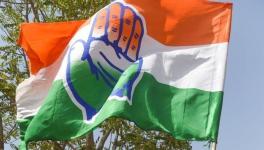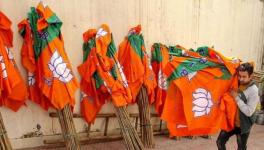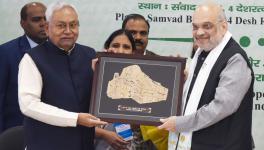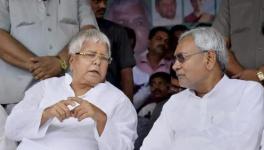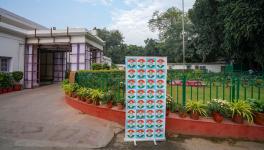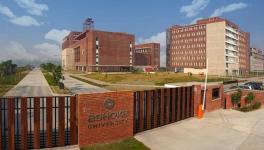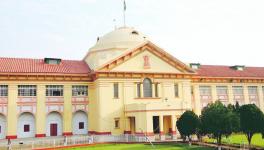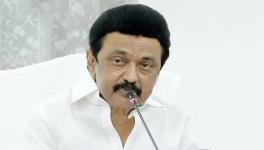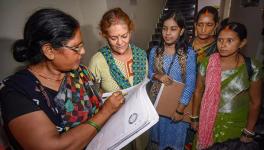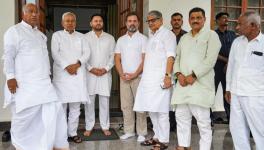Bihar Economic Data a Turning Point in Democracy
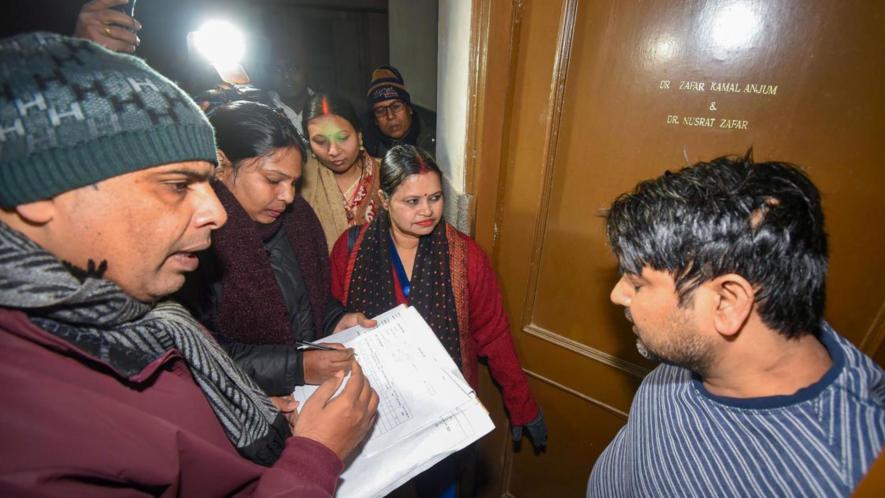
Enumerators receive information from a Patna resident during a caste-based survey in Bihar. Image Courtesy: PTI
After the Bihar government released a broad composition of the caste-wise population of the state in October, it recently released the statistical findings on the socio-economic status of the state’s population. The data shows that the Other Backward Classes of the state constitute 63.13% and the non-Muslim upper castes constitute just 10% of the population. As a single caste, the Yadavs constitute the largest number, 14.27%. The picture is as follows:
The castes that make up the backward (27.13%) and most backward communities (36%) together constitute 63.13% of the state's population. The general category castes, which constitute the Brahmins, Bhumihars, Kayasthas and Rajputs, constitute just 15.52% of the population.
In other words, the Yadavs are virtually as large a social group as all the communities that make up the general category in that state.
If the Muslim population is excluded, the Hindu OBCs constitute 50% of the population and the upper caste (general) category constitutes just 10%.
Impact of Caste Census
An immediate question arises, how would the caste census play out in terms of judicial decisions at the Supreme Court level? The 50% cap imposed on all reservations is based on a moral premise raised by the court. Once such authentic data of caste composition is placed before the court the cap would have to go.
Once a caste census is conducted at the all-India level, the whole political structure will undergo a radical change.
This understanding of social composition was the reason why the Dwija caste leaders in all parties were afraid of collecting caste-wise Census data.
After the caste-wise socio-economic and educational data was tabled, the Bihar government decided to increase the OBC reservations to 65% in the state. Including the EWS reservation, the reservation in Bihar would now rise to 75%.
This decision of the Nitish Kumar and Tejashwi Yadav government will create an ideological crisis for the Bharatiya Janata Party. It will also force the judiciary to relook at its 50% cap on quotas, now that a solid database can be placed before it, at least from one numerically large state.
Poverty Indicators
Let us also look at the caste-wise poverty levels in Bihar. Those who earn less than Rs 6,000 per month are considered the ‘poorest of the poor’ in any state. That is, these families earn less than Rs 72,000 per year. In the 21st-century and in a globalised world, such a poor income can hardly sustain a wife and husband and their two children.
The poverty line defined by the erstwhile Planning Commission’s economic surveys and the existing Niti Aayog’s surveys establish that Bihar is the most poverty-ridden state in India, after which come Uttar Pradesh and Madhya Pradesh. For this reason, along with Rajasthan, these states are also clubbed together as the ‘BiMaRU states’.
Now, the Bihar caste census data shows the caste-wise poverty situation for the first time. It is seen quite clearly that 42.93% of the Scheduled Castes are living in absolute poverty. The Scheduled Tribes follow the Scheduled Castes in terms of having a poverty ridden life with 42.7% among them absolutely poor.
The Extremely Backward Classes constitute the largest grouping in population terms, but in terms of poverty they are worst-off among the OBCs—33.58% of them fall in the category of the poorest of the poor.
Further, 33.16% of the OBCs are in the most poverty-ridden category. The data shows that the Yadavs, though numerically dominant, have 35.87% in the most poverty-stricken category.
Indeed, a section of the Brahmins—25.32%— and 27.58% of the Bhumihars, followed by 24.89% of Rajputs suffer from poverty. The least poverty ridden caste is the Kayastha, among whom 13.38% are poor.
However, we must understand that even among the ‘poorest of the poor’, those who belong to the historically oppressed castes are more lacking in education and caste capital.
Therefore, when we examine caste as a unit, the Scheduled Castes, Scheduled Tribes and EBCs of Bihar need a lot of welfare push apart from mere reservations.
The agrarian productivity in Bihar needs to be upgraded because the state hardly has any industrial capital. In terms of economic vibrancy, its urban locations, including the state capital Patna, though known as ancient Pataliputra, is nowhere close to even a district headquarter in a South Indian state. Unless the state’s productivity is upgraded, pushing its vast population above the poverty line is impossible.
National Implication of Bihar Data
One major implication is that several states are now forced to collect caste-wise data. The Rajasthan and Andhra Pradesh governments have already started collecting caste-wise data.
After the Bihar caste data was released, the Congress party’s All-India Congress Committee met and decided that caste data will be collected wherever it is in power. When the Congress comes to power at the Centre, it would make the caste census part of the general census enumeration, done once in a decade.
This new development is a shocker to the Rashtriya Swayamsevak Sangh (RSS), which is ruling the nation through its brainchild, the BJP. The reason is simple. The RSS was for removing reservations and forbidding any discussion on caste identity. Their idea of social engineering was to convince the Dalit/Shudra masses that the Hindus must unite to fight Muslims and Christians, not to expand caste identities and create a crisis in the Dwija-controlled Sanatana Dharma.
With great reluctance, they allowed Prime Minister Narendra Modi to use his OBC identity in the 2014 election for vote-garnering purposes. They perhaps believed that he would manage the nation as he managed Gujarat by constantly using ‘Muslim appeasement’, ‘Muslim enmity’ and ‘Pakistan threat’ and so on, without allowing the caste question to enter the political discourse.
But India is not Gujarat. Modi’s caste identity and his vote mobilisation based on caste identities in North India, particularly in Uttar Pradesh, became the driving force for the Mandalites to push the caste identity issue towards its logical end.
Now the RSS/BJP will be forced to take a stand on the national caste census. If they avoid the issue, the entire Shudra/OBC masses will come to realise that their vote power was only used to consolidate Dwija power.
The Prime Minister has repeatedly said in his 2023 state election campaigns that his government has made 27 OBCs ministers. He has also been saying that the caste census will divide Hindu society.
Such arguments will only show that they do not want to uplift the historically oppressed OBCs at the ground level. A caste census is about allocating resources and planning for the welfare of each community, based on its actual status and led by scientific data. No party can avoid the question of caste census now.
The author is a political theorist, social activist and author. His latest book is The Clash of Cultures—Productive Masses Vs Hindutva—Mullah Conflicting Ethics. The views expressed are personal.
Get the latest reports & analysis with people's perspective on Protests, movements & deep analytical videos, discussions of the current affairs in your Telegram app. Subscribe to NewsClick's Telegram channel & get Real-Time updates on stories, as they get published on our website.









